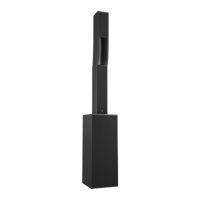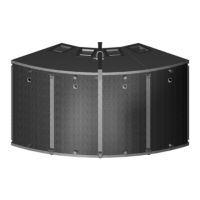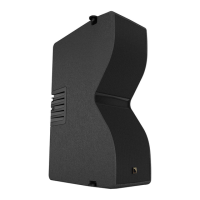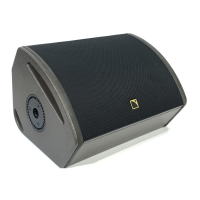L-ACOUSTICS MTD Manual V1.2 11/30/2004 43
5.4 PREDICTING MTD COVERAGE
Polar data files are available for modeling MTD108a, MTD112b and MTD115b coverage using
industry-standard EASE or CATT-Acoustic room acoustics modeling software packages (see Figures
20-22 for examples of typical SPL mappings).
For more information on these modeling programs, please consult:
www.ada-acousticdesign.com
for EASE information
www.catt.se
for CATT.
MTD108a, MTD112b and MTD115b polar data (EASE or CATT format) is available for download
from:
www.l-acoustics.com.
5.5 DISTRIBUTED SOUND REINFORCEMENT
As seen in Figure 22, distributed sound reinforcement using MTD enclosures can provide even SPL
coverage and frequency response by reducing the effects of audible interference. For distributed
installation, the optimum spacing between enclosures will depend on the listener distance and the
coverage angle of the individual enclosure (-6 dB points are 100 degrees for MTD108a, 85 degrees for
MTD112b, 85 degrees for MTD115b).
5.5.1 OVERHEAD DISTRIBUTED SYSTEMS
Overhead distributed system design using coaxial loudspeakers is described in Davis and Davis, Sound
System Engineering, 2
nd
Edition, Focal Press, 1997. In this reference it is shown that an overhead
crisscross pattern distribution density with center-to-center overlap provides the most uniform
coverage (+/- 2 dB variation in SPL from between 250 – 5k Hz is possible). Formulae are provided for
various cases: center-to-center overlap, minimum overlap or no overlap in order to determine
physical layout parameters for the distributed loudspeaker grid. Interested readers are referred to
Chapter 13, “Distributed Sound Systems” in Sound System Engineering
for complete details.
5.5.2 DELAY SYSTEMS
MTD enclosures are highly suited for delay system installation in order to cover large audience areas.
When installing delay systems, there are a few principles that should be followed:
1) Over-delaying up to 15 ms is acceptable due to the Haas effect. Greater than 15 ms is not
acceptable since the delayed sound will be perceived as an echo behind the main signal. Time
alignment of delays should be made using a measurement point on the axis of the reference source
and the delayed source. If the delay time setting is such that the two sources arrive at the same time
on-axis, the reference source will be slightly ahead of the delay source at any other location off-axis
and the Haas effect will allow for correct localization. For some applications (speech), it is advised to
under-delay in order to optimize off-axis intelligibility and clarity behind the delayed system (i.e.,
closer to the stage).
2) Spread different sources, with different delayed signals, instead of grouping them in a single
location. This allows for broader coverage by the delayed sources and produces more homogeneous
SPL over the delay-covered area.
3) Distributed delay positions should be along a circular arc of constant radius, centered at the stage.
4) The optimum spacing between delay loudspeakers will depend on the coverage angle of the
enclosure (100, 85 and 85 degrees for MTD108a, MTD112b and MTD115b, respectively) as well as
the distance to first members of the audience. Center-to-center overlap based on the -6 dB coverage
angles will provide the most uniform coverage (see also 4.5.1).
Time domain-based measurement equipment is highly useful for setting delay times (for example,
MLSSA, WINMLS, TEF, SMAART or SPECTRAFOO). Alternatively, Bushnell Yardage Pro rangefinder
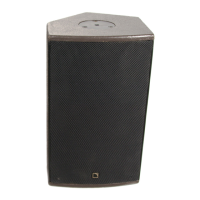
